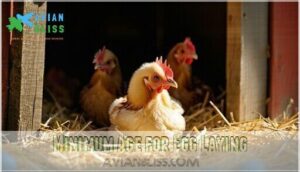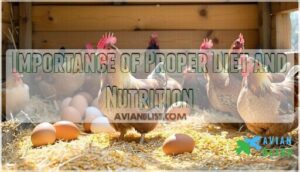This site is supported by our readers. We may earn a commission, at no cost to you, if you purchase through links.

High-production breeds like Leghorns can lay almost daily during their prime, while heritage breeds produce fewer eggs.
Your hen’s age matters too – young hens start laying around 18-24 weeks and hit peak production in their first year.
Factors like daylight, nutrition, and stress levels directly impact how often chickens lay eggs.
During winter months, many hens naturally slow down or stop laying due to shorter days.
The key is understanding that consistent daily laying isn’t the norm for most backyard flocks, but there are proven ways to optimize their natural cycles, and considering factors like these can help, and also knowing that high-production breeds and heritage breeds have different production rates.
Table Of Contents
- Key Takeaways
- Factors Affecting Chicken Egg Laying
- How Often Do Chickens Lay Eggs
- When Do Chickens Start Laying Eggs
- Chicken Egg Laying Cycle and Duration
- Do Chickens Lay Eggs Every Day
- Why Chickens Stop Laying Eggs
- Chicken Breeds With High Egg Production
- Managing Chicken Egg Production
- Frequently Asked Questions (FAQs)
- How many eggs does a chicken lay a week?
- How often do Modern Game chickens lay eggs?
- How often do hens lay eggs?
- How long does it take a chicken to lay eggs?
- What is the 90 10 rule for chickens?
- How do chickens keep laying eggs without a rooster?
- How often do backyard chickens lay eggs?
- What are three disadvantages of raising backyard chickens?
- How many hours a day do chickens lay eggs?
- How many eggs can one eat per week?
- Conclusion
Key Takeaways
- You’ll get 4-6 eggs per week from most healthy hens, as they lay one egg every 24-26 hours during their prime laying period between 18 months to 3 years old.
- Your chicken’s breed determines egg production – Leghorns can lay almost daily with 280-320 eggs yearly, while heritage breeds produce fewer eggs but maintain consistent quality.
- You can boost egg laying by providing 14-16 hours of light daily, quality 16% protein layer feed with calcium supplements, and maintaining stress-free environments with proper nesting boxes.
- Your hens will naturally slow down or stop laying during winter months, molting periods, and when facing health issues, predator stress, or poor nutrition – all factors you can manage through proper care.
Factors Affecting Chicken Egg Laying
Your chicken’s egg production depends on several key factors that work together to determine how many eggs you’ll collect each day.
Your daily egg count depends on breed, age, diet, and daylight hours working together perfectly.
These factors include your hen’s breed and age, her diet quality, seasonal changes in daylight, and environmental stress levels in her living space, which are all crucial for optimal production.
Breed and Age
Breed influence shapes your hen’s egg laying frequency more than you’d think.
Most chicken breeds begin their laying onset around 18-22 weeks, but breed comparison reveals big differences.
Leghorns hit peak production fastest, while heritage breeds take longer.
Egg laying age matters too – expect stellar performance in years one and two, then watch age decline kick in as production drops substantially.
Diet and Nutrition
Your hens need proper feed composition to maintain steady chicken egg production. Quality 16% layer feed provides adequate protein intake, while calcium sources like oyster shells strengthen eggshells.
Don’t overlook hydration needs – fresh water keeps your flock laying consistently. Smart supplementation strategies include offering chicken nutrition boosters like mealworms.
Think of egglaying nutrition as fuel for your backyard egg factory. For convenient options, you can explore various layer feed products. Poor diet means fewer eggs, so invest in quality feed for better egg laying frequency.
Season and Daylight Exposure
Sunlight acts as nature’s egg production switch for your flock.
Seasonal egg laying follows daylight hours closely, with hens needing 12-14 hours of light exposure for consistent production.
Here’s how light affects your chicken lighting needs:
- Spring brings peak egg laying season with lengthening days
- Summer heat can reduce production despite long daylight hours
- Winter production drops dramatically without artificial lighting
- Artificial light maintains steady output year-round
Environmental Stress
Your chickens’ stress levels directly impact their egg laying performance.
When hens face predator stress, overcrowding effects worsen dramatically.
Poor coop conditions create laying disruption that tanks egg production by 25-45%.
Weather extremes trigger similar drops in chicken health and egg quality.
Weather changes
How Often Do Chickens Lay Eggs
You’ll find that most healthy hens lay one egg every 24 to 26 hours once they reach maturity, which typically means four to six eggs per week.
Most healthy hens deliver a fresh egg every 24-26 hours, giving you 4-6 eggs weekly once they hit their laying stride.
This frequency depends on several key factors including the hen’s breed, age, diet, and the amount of daylight she receives each day, which are all crucial for determining the overall egg-laying frequency.
Egg Laying Frequency by Breed
Your chicken’s breed determines how many eggs land in your basket each week.
Here’s what you can expect from top egglaying breeds:
- Leghorn frequency reaches 6-7 eggs weekly with consistent white egg production
- Rhode Island Reds deliver 4-6 brown eggs per week reliably
- Easter Egger output produces 4-5 colorful eggs weekly
- Plymouth Rock eggs average 4-5 brown eggs each week
- Sussex production maintains steady 4-6 cream-colored eggs weekly
Average Number of Eggs Laid Per Week
Most backyard flocks deliver 4-6 eggs weekly per hen, though Weekly Egg Count varies substantially.
Breed Variations mean some champions produce daily while others rest between cycles.
Age Influence reduces output from peak years, and Dietary Impact affects consistency.
Your average eggs per week depends on proper nutrition and care.
Seasonal Averages drop during winter months, creating natural egg laying decline patterns you’ll notice.
Factors Influencing Egg Production Rate
Multiple factors directly impact your hen’s egg laying frequency throughout her productive years. Nutrition Impact plays a vital role – inadequate protein or calcium causes immediate egg laying decline. Environmental Stressors like overcrowding reduce production substantially.
Key influences on your flock’s performance include:
- Breed Variation determines baseline laying capacity and cycle patterns
- Light Exposure triggers hormonal responses that regulate daily egg production
- Molting Effects temporarily halt laying as chickens regenerate feathers
Understanding these factors affect laying helps optimize your chicken breeds egg output.
When Do Chickens Start Laying Eggs
You’ll see your first eggs when your chickens reach 18 to 22 weeks old, though some breeds start as early as 5 months while others take up to a year.
The exact timing depends on your chicken’s breed, diet, and the season when they mature, with proper nutrition and longer daylight hours helping them start laying sooner, influenced by factors like nutrition.
Minimum Age for Egg Laying
Your pullets won’t start their egg laying frequency until they reach maturity. Most chickens begin laying between 18-22 weeks old, though this varies by breed onset and individual development.
Diet impact plays a major role – keep young birds on 18% chick starter until you notice egg laying signs like red combs and squatting behavior.
Seasonal effects and light influence can affect timing, while stress becomes a significant delay factor.
Watch for classic egg laying behavior like exploring nesting boxes. Remember, pushing your pullet to lay early through artificial methods won’t help their long-term pullet egg laying success.
Breed-Specific Egg Laying Age
When comparing different breeds, you’ll find breed maturity age varies substantially.
Laying onset factors include genetics and size, with breed early layers starting production sooner than their larger counterparts.
Here’s what to expect for hen egg laying timing:
- Production breeds like Rhode Island Reds begin their egg laying cycle at 18-20 weeks
- Heritage breeds such as Buff Orpingtons start around 24-26 weeks
- Delayed laying breeds like Silkies wait until 28-32 weeks for peak chicken egglaying frequency
Importance of Proper Diet and Nutrition
Your hens need the right fuel to maintain consistent egg laying frequency. Poor chicken egglaying nutrition leads to nutrient deficiencies that cause egg laying decline and affect overall egg laying health.
Birds reach sexual maturity at different rates depending on the species.
| Feed Type | Protein % | Purpose |
|---|---|---|
| Chick Starter | 18% | Growth phase |
| Layer Feed | 16% | Ideal layer feed for production |
| Calcium Supplement | N/A | Strong shells |
Meeting protein requirements and calcium supplementation prevents dietary impact on hen egg laying performance. Some species exhibit unique egg-laying methods.
Chicken Egg Laying Cycle and Duration
You’ll find that your hens hit their peak egg production during their first year, laying up to 250-300 eggs annually.
Understanding this natural cycle helps you plan for changes in your flock’s productivity, as most hens produce about 80% fewer eggs by their fourth year compared to their prime laying period.
Prime Laying Years
Your chickens will reach their peak production during their first 18 months of laying.
These prime years deliver consistent daily eggs with excellent egg quality under optimal conditions. Chicken age directly impacts performance, with young hens maintaining steady egg laying frequency throughout this golden period.
Here’s what defines prime laying years:
- Peak production occurs between 6-18 months of age
- Egg laying frequency averages 5-6 eggs weekly
- Breed longevity varies, affecting prime year duration
- Egg quality remains consistently high during this phase
- Optimal conditions maximize these productive egg laying years
Peak Production and Decline
During the first two years, your hens hit their peak laying stride, producing 5-6 eggs weekly with remarkable consistency.
This golden period showcases ideal egg laying frequency before the inevitable production decline kicks in.
Age impact becomes noticeable after year three, when chicken egglaying cycle shifts and poultry egglaying frequency drops to about 80% of original output.
Providing hens with high protein chicken feed can help sustain egg production.
Environmental factors and breed differences influence how gradually this egglaying decline progresses in your flock.
Average Lifespan of Egg-Laying Hens
Your feathered friends naturally live 8-10 years, though their egglaying capacity changes dramatically over time.
Most hens enjoy their prime egglaying years during ages 1-3, with production steadily declining afterward.
Understanding breed longevity helps set realistic expectations:
- Commercial hybrids like ISA Browns live 2-3 years due to intensive egglaying frequency
- Heritage breeds often reach 6-8 years with better health impact
- Backyard flocks typically survive longer than commercial operations
- Egglaying decline accelerates after year three, dropping to 60% capacity
- End-of-life care becomes important as lifespan factors affect overall chicken egglaying decline.
Even retired hens contribute by pest control and flock protection.
Do Chickens Lay Eggs Every Day
You won’t see an egg in your nesting box every single day, even with healthy hens.
Most chickens lay eggs every 24 to 26 hours, which means they’ll produce about four to six eggs per week, with occasional rest days between laying cycles.
Time of Day for Egg Laying
Since sunrise triggers their internal clock, most hens lay eggs within six hours of daylight.
This morning bias creates laying consistency you can count on.
Light sensitivity varies by breed, but expect fresh eggs before noon during peak season.
Understanding this egg laying process helps optimize your collection routine.
The egg cycle follows natural patterns, making egg-laying behavior predictable.
Check nesting boxes mid-morning for best results and fresher eggs, as this is a key part of the egg laying process.
Year-Round Egg Production
Your backyard flock’s year-round egg production naturally fluctuates with seasonal changes, but you can maintain more consistent output through proper management.
Here’s how to optimize production throughout all seasons:
- Winter Egg Production drops to 60-70% due to shorter daylight hours
- Breed Selection matters – cold-hardy varieties maintain better winter laying
- Chicken Feed quality becomes essential during colder months for energy
- Optimal Conditions include draft-free coops and consistent temperatures
- Molting periods temporarily halt production regardless of season
Understanding these patterns helps you plan accordingly.
Role of Artificial Lighting
Light affects your chicken egglaying cycle more than you’d think. Artificial lighting extends the photoperiod impact during shorter winter days, keeping hens productive when natural daylight drops below 14 hours.
Install automated systems with timers for consistent results – no need to remember daily schedules. Light spectrum matters too; warm white LEDs work best for energy efficiency. Set optimal intensity around 10-15 lux at bird level.
Artificial light exposure can disrupt a bird’s natural breeding cycles, sometimes causing unintended egg laying. These egg laying tips help increase egg production year-round, giving your flock steady laying conditions regardless of season.
Why Chickens Stop Laying Eggs
You’ve been collecting fresh eggs daily, but suddenly your hens have stopped laying, and you’re wondering what went wrong.
Several factors can interrupt your chickens’ egg production, including seasonal changes, health problems, stress, poor nutrition, and their natural molting process.
Common Reasons for Reduced Egg Production
Discovering why your hens have stopped laying eggs often points to several key factors.
Nutrient deficiencies, especially calcium and protein shortages, directly impact egg production.
Predator stress from foxes or hawks keeps hens on edge, while molting impact naturally halts laying for weeks.
Disease effects like parasites drain energy, and inadequate water availability compounds these common egg problems affecting your egglaying cycle.
Seasonal Changes and Egg Laying
Nature’s clock controls your hens’ egg production more than you might realize. Winter Egg Production drops substantially when daylight shrinks below 14 hours daily. Summer Heat Effects can halt laying when temperatures soar.
Here’s how seasons impact your flock:
- Spring Laying Peak – March through May delivers maximum eggs
- Autumnal Decline – September’s shorter days trigger production slowdown
- Molting Impact – Fall feather replacement stops laying temporarily
- Sunlight Requirements – Hens need consistent daylight for steady egg production
Health Issues and Egg Laying
When your chickens face health problems, their bodies shift focus from egg formation to survival, drastically reducing healthy egg laying.
Disease impact on your flock can halt production within days, while chronic issues create long-term laying problems.
Common health issues affecting egglaying health include:
- Parasites effect – Mites and worms drain energy, causing weak hens who can’t sustain daily laying
- Calcium deficiency – Creates soft-shelled eggs and weakens bones, forcing hens to stop laying entirely
- Nutrition problems – Poor feed quality leads to irregular egg formation and decreased production
- Stress effects – Overcrowding, predators, or environmental changes trigger hormonal imbalances that stop laying
Monitor your flock daily for early disease detection.
Chicken Breeds With High Egg Production
If you’re looking to maximize your egg basket, choosing the right chicken breed makes all the difference in your daily collection routine.
Some breeds consistently lay over 300 eggs per year, while others produce fewer than 200, so understanding these differences helps you pick the best layers for your needs, and make informed decisions to achieve your desired daily collection.
Leghorn and Rhode Island Red
When choosing top egg-laying breeds, Leghorns and Rhode Island Reds lead the pack.
Leghorns produce exceptional egg quantity with 280-320 white eggs annually, while Rhode Island Reds offer excellent temperament alongside 250-300 brown eggs yearly.
This breed comparison shows Leghorns excel in pure production, whereas Rhode Island Reds function as dual-purpose breeds, providing both eggs and meat for backyard flocks.
Easter Egger and Plymouth Rock
Easter Eggers are crowd-pleasers in the egg production world, delivering colorful blue and green shells that make your daily collection exciting.
These friendly laying hens produce 4-5 eggs weekly, totaling around 250 annually. Their breed temperament makes them perfect for families seeking backyard suitability.
Plymouth Rock chickens are reliable dual-purpose breeds that excel at egglaying while providing substantial Plymouth Rock size for meat production. You’ll get 4-5 brown eggs per week, reaching 280 yearly.
Both breeds offer excellent egg production rates, though Easter Eggers stay less broody, ensuring more consistent laying patterns throughout the season. To keep hens productive, consider the importance of consistent feeding habits.
Sussex and Other High-Producing Breeds
Sussex chickens shine as dual-purpose breeds, delivering 250 light brown eggs annually with friendly temperaments perfect for backyard chickens eggs.
You’ll love their consistent Sussex egg laying alongside other high-yield breeds like Australorps (280+ eggs) and Orpingtons (200-280 eggs).
These laying hens combine excellent egg production with docile personalities, making temperament comparison easy when choosing chicken breeds for your flock’s daily needs.
Managing Chicken Egg Production
You can boost your flock’s egg production by controlling their lighting schedule, providing proper nesting boxes, and collecting eggs daily.
These simple management practices help your hens lay consistently while keeping the eggs clean and fresh for your family.
Lighting Schedules and Nesting Boxes
Proper artificial lighting and well-designed nesting boxes create the perfect egglaying environment for your flock. Your chicken coop needs consistent light duration of 14-16 hours daily to maximize production.
Many people purchase nesting boxes for their coops.
Here’s your egglaying management checklist:
- Position one nesting box per 4-5 hens in quiet corners
- Use soft nesting materials like straw or wood shavings
- Make certain predator-free nesting areas with coop darkness
- Follow these egglaying tips for consistent results
Egg Collection Routine
Smart egg collection starts with understanding your flock’s egglaying patterns. Most hens follow predictable egglaying habits, laying eggs within six hours of sunrise. You’ll want to establish a consistent routine timing for daily egg count – aim for midday collection to catch the morning’s production.
Handle eggs with clean, dry hands to prevent contamination. Proper handling means avoiding sudden movements that might crack shells. For egg storage, keep them in cool conditions immediately after collection.
Collection frequency matters more than you’d think. Daily egg collection prevents hens from becoming broody and keeps eggs fresh. Consider using a durable gathering solution for efficient collection. Track your chicken egg laying patterns to spot any changes in production that might signal health issues.
Tips for Maintaining Healthy Egg-Laying Hens
Collecting eggs daily sets the foundation, but keeping your hens healthy requires ongoing attention to chicken care fundamentals.
Optimal Nutrition starts with quality layer feed containing 16% protein and calcium supplements.
Your chicken egglaying health depends on these five management practices:
- Coop Management – Provide 4 square feet per bird with proper ventilation
- Health Monitoring – Check for droopy wings and pale combs weekly
- Predator Protection – Secure fencing prevents stress-induced production drops
- Breed Selection – Choose productive varieties for consistent laying
- Fresh Water – Change daily to support poultry health and chicken egglaying management
Frequently Asked Questions (FAQs)
How many eggs does a chicken lay a week?
You’ll typically get 4-6 eggs weekly from your healthy hen. Most chickens lay one egg daily during peak production, though they’ll take occasional rest days between laying cycles.
How often do Modern Game chickens lay eggs?
Modern Game chickens aren’t prolific layers, producing only 1-2 small eggs per week.
You’ll get around 50-80 eggs annually from these ornamental birds, as they’re bred primarily for their striking appearance rather than egg production.
How often do hens lay eggs?
Like clockwork ticking through nature’s rhythm, your hens will gift you one precious egg nearly every day once they’re mature.
Most healthy ladies lay consistently every 24-26 hours during their prime laying years.
How long does it take a chicken to lay eggs?
Chickens start laying eggs around 18-22 weeks old, depending on their breed.
Once they begin, you’ll see one egg every 24-26 hours during their peak laying period, which lasts several years.
What is the 90 10 rule for chickens?
Imagine your flock as a thriving business: 90% of their eggs come from 10% of prime conditions. The "90/10 rule" means focusing on light, nutrition, and care to optimize egg production.
How do chickens keep laying eggs without a rooster?
You don’t need a rooster for egg production.
Hens naturally release eggs from their ovaries in a 24-hour cycle, creating unfertilized eggs that are perfectly normal and safe to eat daily.
How often do backyard chickens lay eggs?
Steady as clockwork, your backyard hens will produce eggs every 24-26 hours once they reach maturity.
Most healthy chickens lay 4-6 eggs weekly, though this varies by breed, age, season, and diet quality.
What are three disadvantages of raising backyard chickens?
Raising backyard chickens has drawbacks: they need daily care that demands time, coop maintenance is frequent and messy, and feed costs can add up.
Plus, predators pose a constant threat to their safety.
How many hours a day do chickens lay eggs?
Chickens don’t lay eggs for specific hours each day.
Your hens produce one egg every 24-26 hours, typically laying within six hours after sunrise, then taking about a day to form the next egg.
How many eggs can one eat per week?
Most healthy adults can safely eat 7-14 eggs weekly without concern.
Your cholesterol levels, overall diet, and health conditions matter more than egg count.
Listen to your body and consult your doctor if you have specific dietary restrictions.
Conclusion
Understanding how often chickens lay eggs puts you in control of your flock’s productivity.
Like a well-tuned engine, your hens need the right fuel, environment, and care to perform their best.
Most chickens produce 4-6 eggs weekly, but you can optimize this through proper nutrition, adequate lighting, and stress management.
Remember that breed, age, and season all play vital roles.
With consistent care and realistic expectations, you’ll enjoy fresh eggs from your backyard flock year-round.













